Thinking of splashing out some cash on Christmas dinner? Beef tenderloin (the cut that gives you filet mignon steaks) is a classic “wow, nice meal” choice for the omnivores.
There’s no getting around it: this is a spendy cut of meat – the grass-finished tenderloins I’m hacking up here cost me $15.95 a pound. But you can save a bit of money (and control the quality of the cutting) if you start with a whole beef tenderloin and fabricate (fancy meat word meaning “trim and cut”) it yourself. Finished grass-fed steaks might cost me $28 a pound or more, and even when you factor in unusable trim you typically save money DIY’ing your filet mignon.
And it’s really not hard – the tenderloin is a very manageable 4-6 pound piece of meat, and nothing more than a sharp knife and a cutting board is required. So don’t be scared! This is a straightforward piece of meat on which to practice your fabrication skills. Just go slow – you’re not going to mess anything up.

Meet Your Meat
This is what a whole beef tenderloin looks like. If you buy wholesale this cut is typically sold Cryovac’d (like industrial Seal-a-Meal) and there will be some blood and meat juice in the bag with the tenderloin. If you are buying from a butcher’s case, chances are extremely good that the tenderloin they sell you came to them in the exact same kind of bag, but they will have already opened the bag and patted the meat dry for you.
In any event, pat your tenderloin dry and assess what you are working with.
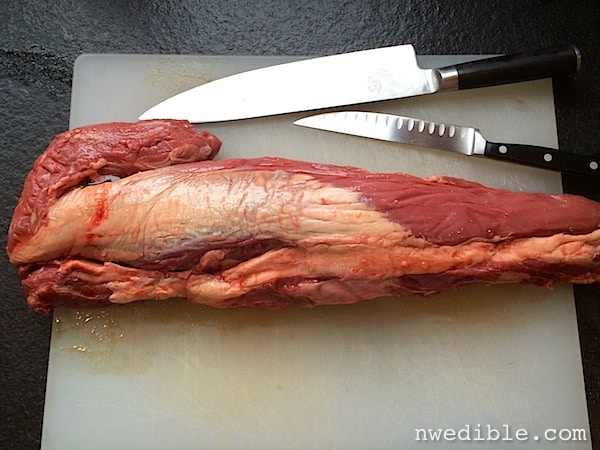
There are two parts to this tenderloin that you need to remove. The first is called the “Chain” and the second is called the “Silverskin.”

Remove The Chain
The Chain is that fat-covered portion of meat at the bottom of the tenderloin. Use your fingers to break through the connective tissue holding that section to the tenderloin. Most of it will peel off quite easily.

Use just the tip of your sharp knife to finish slicing through any connective tissue that doesn’t separate easily from the main portion of the tenderloin. At the thick, head end of the tenderloin cut the chain from the tenderloin.
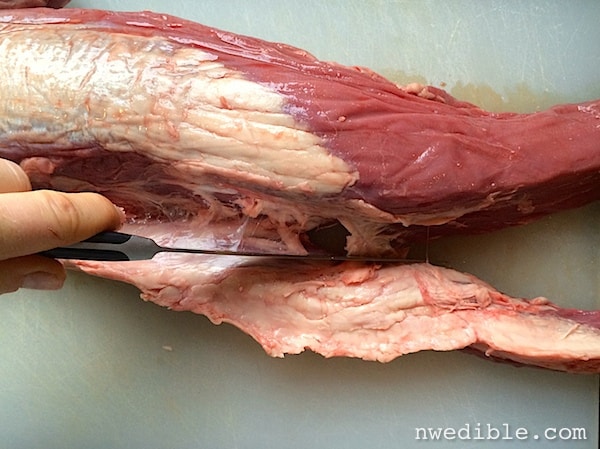
Remove the Silverskin
The silverskin is a very tough, chewy piece of connective tissue that covers more than half the top portion of the tenderloin. If you leave it on you might as well wrap your tenderloin in rubber bands. It’s thin, so the goal here is to remove all the silverskin without cutting off a bunch of meat.
Start by keeping your knife flat parallel to the tenderloin and cut a flap of silverskin off one end. In the picture below, I am just about to slice my knife to the right to create that flap.
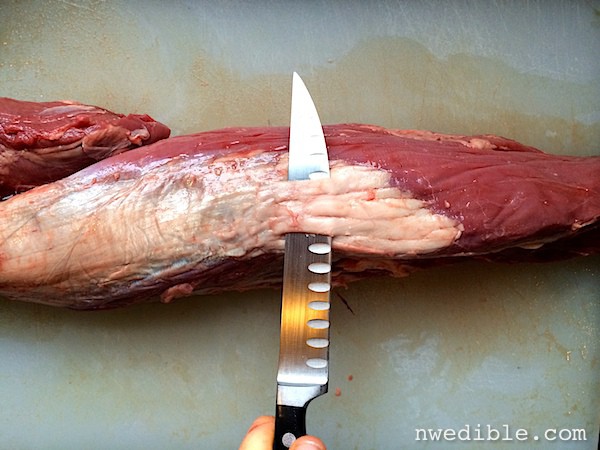
Now I’ve created my flap.
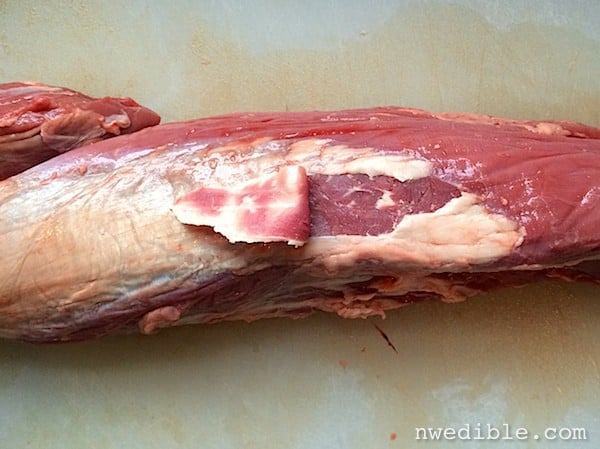
Now turn your knife so that it can slice in the opposite direction and hold that flap tight with your non-knife hand. Ladies, you know how when you wax your legs (or, you know, whatever) how you hold the skin taut in one hand and pull back the wax strip with the other? This is a lot like that, but with a knife.
Run your knife along the inside edge of the silverskin, cutting it free from the tenderloin. I hold my knife so that it slants just slightly up and away from the meat. Try not to let your knife gouge into the meat.
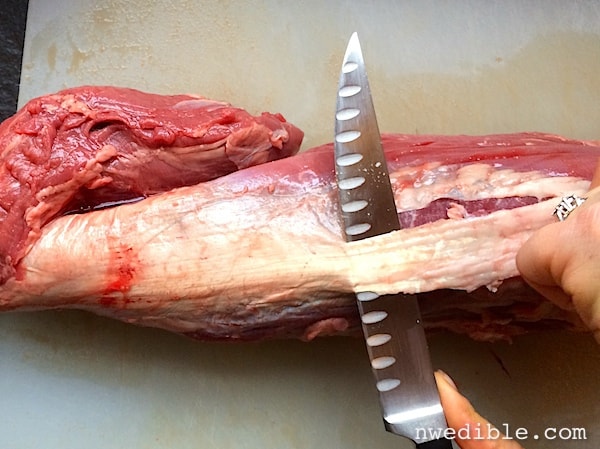
Take off one long smooth strip of silverskin.
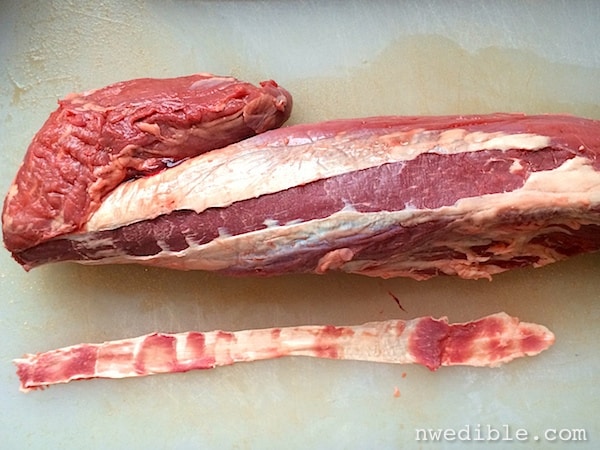
Repeat until all the silverskin is removed, and look over your tenderloin for any scraps of sinew or fat. Check the bottom and cut off any thick hunks of fat. Don’t like to go crazy cutting all the fat off the bottom, though – fat is flavor!
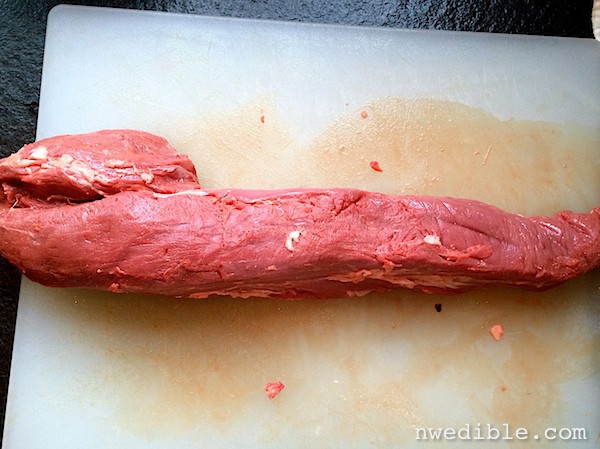
Option One: Tie Whole Tenderloin For Roasting
At this point you have a lovely, whole trimmed beef tenderloin. But note that one end is very thick and one end tapers down to nothing. That isn’t ideal for a roast (uneven cooking, you know how it is) so if you plan to do one big roast, you should tie your tenderloin. You could go for the “a million little belts of string” look, but I prefer to truss my roast butcher style using one long section of butchers twine. There’s a practical reason: this method for tying a roast stays snug and in place as the meat cooks (and shrinks) while lots of little string belts tend to loosen. Once you get the hang of it, it’s also far faster and frankly just looks cooler than a whole bunch of knots all over your roast.
It’s a bit hard to explain how to loop and pull the twine for a butchers truss, which is why I think a lot of recipes wimp out and just tell people to just tie a bunch of sections of string around their roast. But trust me when I say explaining this method is far harder than actually doing it. Once you figure out the motion of the string it’ll become second nature.
I should also note that there are a few ways to do a butcher’s truss and I don’t claim to be the world’s biggest expert. This is the way that makes sense to me, but if you have a way that works better for you, that’s awesome-sauce. So, here’s my best explanation for how to tie your tenderloin with a butcher’s truss.
Start with a piece of butcher’s twine about four times the length of your tenderloin. Leave a little extra so you don’t run short. If you want, you can loop the long end of your string up and over your shoulder to keep it out of the way.
Start at the fat end of the tenderloin, where it looks more like two muscles than one. Loop your string under the tenderloin, like so:
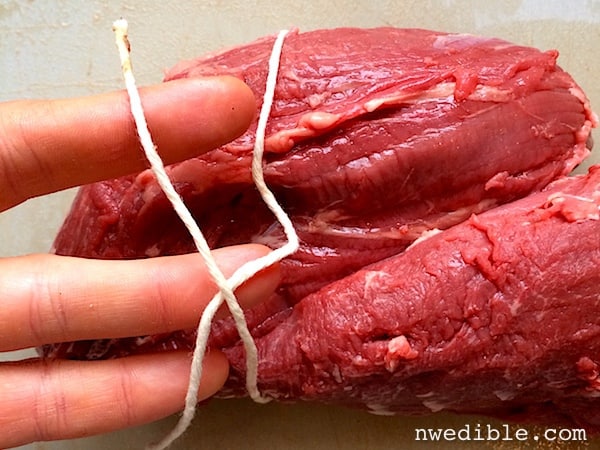
Now twist the twine around itself several times, pull snuggly and knot. The twists will keep the twine from working free. Don’t be afraid to pull the twine very snug – you don’t want to garrote your meat, but the twine should sink into the tenderloin a bit.
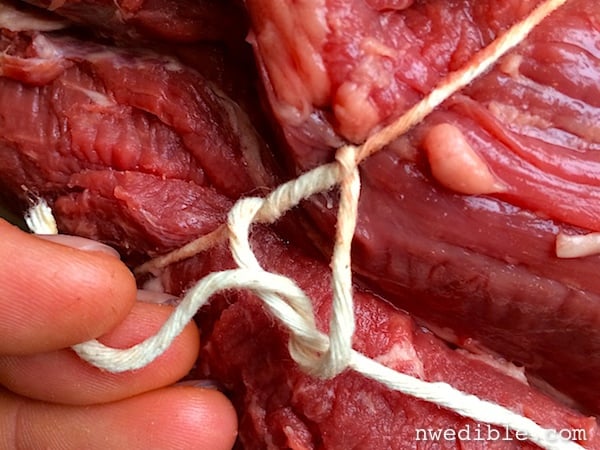
Now comes the fun part. Imagine a center line running down your beef tenderloin. Trail your twine an inch or two down that centerline, then loop the twine under the tenderloin. In the top of the photo below you can see the long end of the twine coming out from below the meat.

Now loop the long end of the twine back over the top of the tenderloin, and catch the “centerline” section of twine so that, when you look down on it, the truss forms a letter H shape. Pull snuggly, wiggling the twine back and forth if necessary to get it to seat snuggly in the meat.
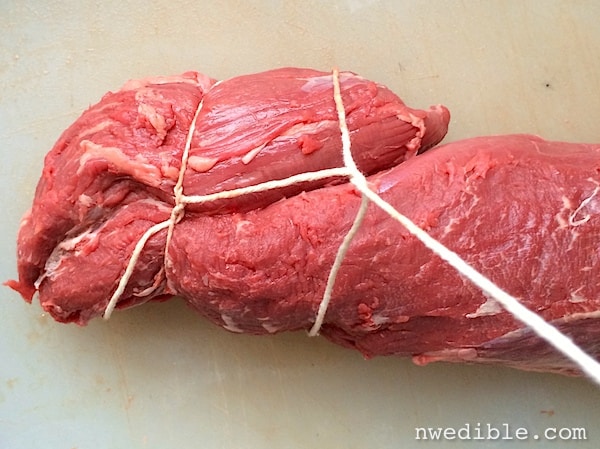
Now repeat that “centerline, loop under, catch and through” motion down the length of your roast.
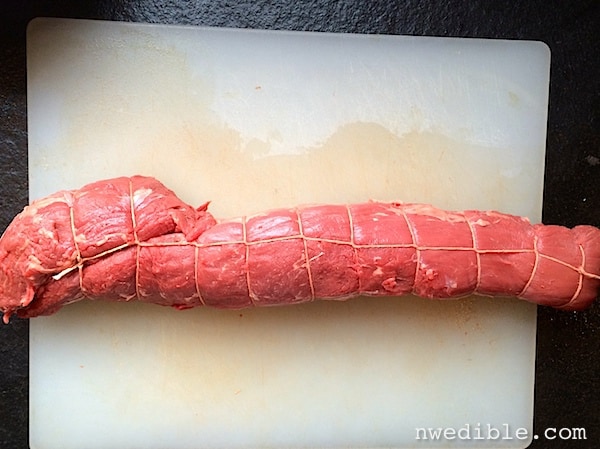
At the narrow end of your tenderloin, tuck the last several inches of roast under itself. This really helps keep the width of the roast more even and prevents that end part from overcooking.

Hold the end bit firmly as you complete your truss, make sure everything is snug.
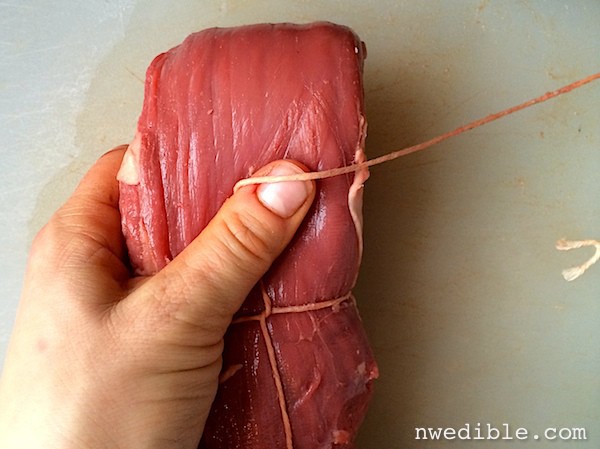
Finish with another twist-twist-knot. On wider roasts, I’d flip the meat over and run the string back up the centerline on the bottom, but for something this narrow, if your twine is snug around the roast there isn’t much risk of the strings moving around in cooking so I don’t worry about it.

Now just season your meat and proceed with your favorite Roast Tenderloin recipe.
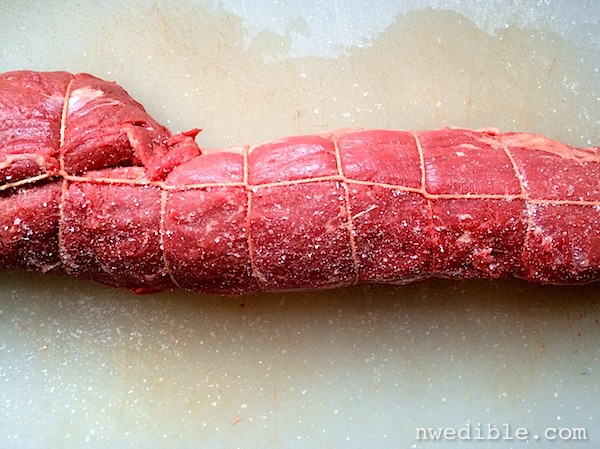
Option Two: Cut Filet Mignon Steaks
Some people will probably point out that not all steaks cut from the tenderloin are technically filet mignon and they might start swinging around terms like centercut and chateaubriand and tournedos. Blah blah blah – you can ignore all that. In the United States, filet mignon is basically a marketing term for a steak cut from the tenderloin, and that’s what we are going to do here.
If you want to go for individual steaks, start with your trimmed up tenderloin.

The last few tapered inches aren’t really wide enough to cut a nice steak from so set that piece aside. That’s the Scooby Snack you get later for all your hard at home beef fabrication work.
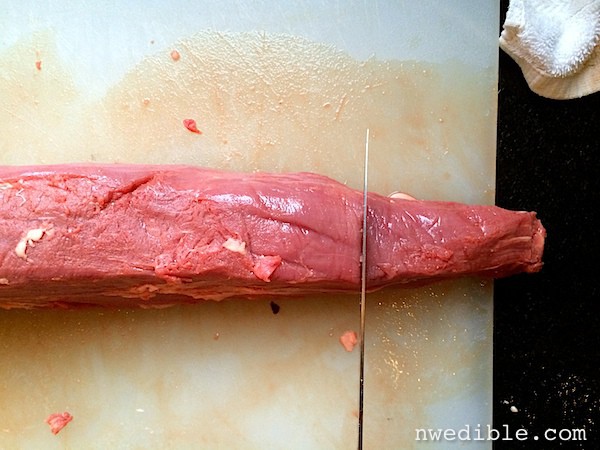
Now use your hands to kind of smoosh the thinner end of the tenderloin up and smooth the middle section in. This will make the tenderloin a more uniform thickness and make it easier for you to cut uniform sized steaks. Cut your first steak – I recommend about an inch-and-a-half in thickness. Then, use that first one as a guide for the reminder for the rest.
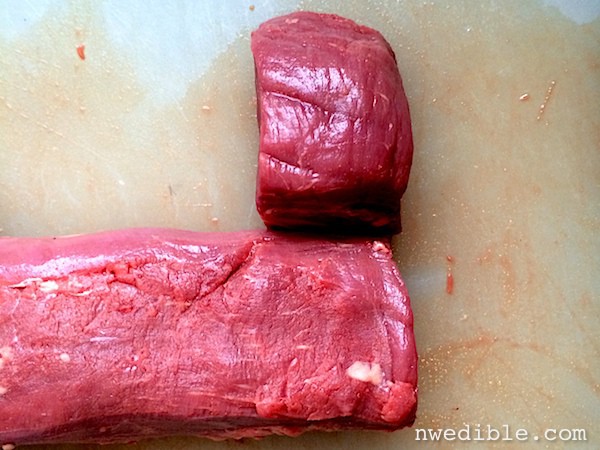
Keep cutting steaks until you get to the head of the tenderloin, where the muscle splits.

At this point I do something a bit unconventional and cut a few more steaks out of this portion of the tenderloin. There’s a pretty natural “dividing line” that I follow where the intramuscular fat is a bit thicker. Slice along that line, gently smoosh the portions as necessary to make more uniform width steaks, and you should get three or four more steaks from the head.
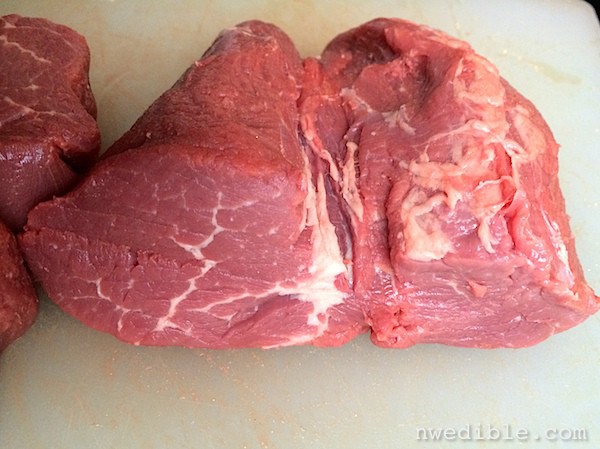
This tenderloin is pretty small, but I was still able to cut three additional nice sized steaks from this area.

Here’s the total from one five pound tenderloin: nine nice-sized tenderloin steaks and about a pound of meat that’s not quite right for steaks but will make an excellent pan fry for the cook.
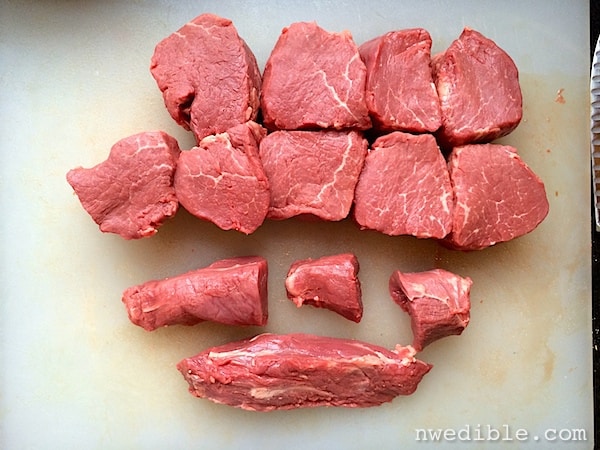
Now just season your steaks and cook as desired. I prefer oil, salt, pepper a screaming hot cast iron skillet but I’m a simple girl.
Tips For Cooking Beef Tenderloin
This is a tender, lean cut of meat. Aim for a doneness of medium-rare to rare. I like to pull a full beef tenderloin roast at about 120 degrees and let it rest for 15 minutes, by which point it’s at 125 and nicely medium-rare. Five degrees higher isn’t going to ruin your steak, if you prefer a slightly more done roast. The US Government’s suggested minimum of 145 degrees for whole muscle roasts is a culinary obscene thing to do to a beef tenderloin. Do what works for you.
Tenderloin is a lovely, cut-it-with-a-butterknife-tender muscle but it’s not really that flavorful. I’m not a huge fan of the bacon-wrapped preparation that is often used to add fat and flavor to this cut, but I do like a sauce with roast tenderloin. A simple blue cheese or herb compound butter is a nice option, or go full on 1950s Steakhouse with Bearnaise Sauce.
Related Stuff…
(These are affiliate links. Purchases made through these links cost you nothing extra but allow me to work body-hair removal jokes into inappropriate places more often. Full financial disclosure here. Thanks for your support, guys.)
Butcher’s Twine – you want all cotton, food safe and unbleached. Not to be confused with garden twine, craft twine, etc.
Good Knives – essential for doing anything in the kitchen, a good knife is an investment. It is far better (and safer) to buy a few good knives that you will have for your whole life than to buy some cheap-o set that will break on you over time. I like, own, and use Wusthof Classic, Shun Classic, and Messermeister Knives. I think everyone needs a chef’s knife, paring knife and bread knife. Everything else is negotiable. Get knifes that fit your hand and keep them sharp. Hone often on a sharpening steel and have them professionally sharpened every 6 to 12 months, depending on how often you use them. Don’t use those roller-sharpener things. They tear up your blade.
Are you preparing a fancy meal this holiday season? What’s on the menu?
206
That was the best explanation I’ve seen ever of how to tie a roast. Thanks!
Thank you for this super useful tutorial! It’s so clearly a much better deal to diy this than to buy ten filet mignons (which: YIKES). This actually reminds me of the time a few years ago when we had a venison tenderloin (from a deer my brother-in-law had shot as opposed to the butcher counter, fortunately for us) for christmas eve dinner–we butterflied it, made it into a roulade with spinach, gruyere, and onion, and pan-fried it until awesome. SO good.
Thank you for the lesson Erica. You made it make sense. And NOT scary.
That’s a neat trick to remove the silverskin, I’m always struggling with it. Have you ever tried to just cook the whole tenderloin (well cut in half) in a pan? Takes about 15 min and you get varying levels of donenes. The ends will be well done (good for the kids or whoever likes well done) while the middle will be medium or medium-rare. I guess it’s similar to making filet Mignon but you get a much juicer finish.
Thanks, Erica.. again you covered every base I could think of, and some I wouldn’t ! Ditto on the silverskin trick. You professionals are so …. slick! Here’s Jaques Pepin deboning a chicken lickety-split, also tying it up at 9:00, and NOW I can see what he’s doing 😉
Great summary! The chain is excellent for meat pies etc, just trim the excess fat, don’t throw it out! When cutting steaks, I sometimes stop when I reach the head end of the loin, leaving it in one whole piece, and trussing it as a “roast for two”.
I cut that hunk of side meat off and cook it later. Also don’t throw away the chain. Cut as much fat as you can off and it makes great beef stew or shredded mexican beef.
This is the best tutorial out there, thanks!!! Your explanation of how to tie the meat up is perfect. Thank you.
I don’t usually go out of my way to comment on articles, etc., but I’ve got to hand it to you: this was an awesome post! Probably one of the most accurate (and realistic) tutorials out there. Thanks!!
Wow. Your explanation seems simple and less stressful to me than YouTube demos. Thanks!